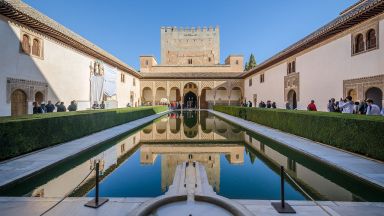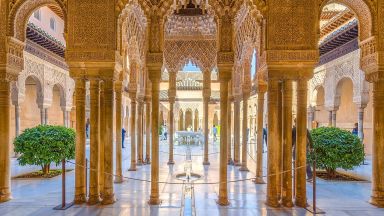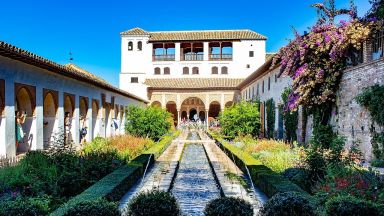Sacromonte
Area in Granada
The Sacromonte district is a district of Granada, located on the Valparaiso hill. It is one of the six neighbourhoods that make up the urban district of Albayzín. The district is famous in Andalusia for its unique gypsy neighborhoods, which are full of caves of flamenco music. The Sacromonte also offers views of the towers of the Alhambra, the white slopes of the Albaycin, the Valparaiso valley and the River Darro.
History of Sacromonte in 1 minute
After the city was retaken by the Catholic Monarchs in the 15th century, Sacromonte became the home for the city’s Jewish and Muslim populations who were expelled from their homes, and intermixed with the nomadic Romani, adopting some of their customs. In the 16th-century the settlers began to hew their homes from the rock-face and created these cave homes in whitewashed caves. the Sacromonte district owes its fame to these houses. The district is on the slopes of Cerro de San Miguel on the edge of the Camino del Sacromonte, the old route of the Guadix Muslims.
Cuevas del Sacromonte
The caves became housing for the marginalized Jewish, Muslim and Romani people and was located outside the walls of the city, which meant being outside of administrative and ecclesiastical control, particularly of the Spanish Inquisition. They are sometimes called troglodyte houses as a troglodyte, is a human being who inhabits a cave or the area beneath the overhanging rocks of a cliff.
The ‘Cuevas del Sacromonte‘ is a museum there are eleven cave houses, where you will find information about the history, traditions and inhabitants of Sacromonte. The caves are grouped around ravines, which helped to form the streets of the area. The caves of Sacromonte have for centuries been the home of gypsies, bohemians and Flemish artists. The Gypsies, like the Jews, are a group that has preserved its pure racial identity over the centuries. As you stroll past these dwellings you’ll notice how no two cave houses are the same, as their dimensions are determined entirely by the difficult terrain.
There are different types of caves.
- The best known to visitors are those devoted to Zambra: spacious, white and adorned with shiny copper pots. These caves of Sacromonte in Granada are located near the road and are easily accessible.
- In the upper part of Sacromonte are the caves in better condition: they have an entrance also serving as a kitchen and dining area, and one or two bedrooms.
Legend of the Ravine of the Blacks
The Barranco de los Negros or Ravine of the Blacks is a legend surrounding the cave dwellings of Sacramonte. When the Moors left or were expelled from Granada they wanted to leave but but did not want to loose their wealth and they were afraid of being robbed on the way to the lands in Africa. So they hid their treasures in the olive groves of and hillside of Sacramonte. Meanwhile the moors released most of their slaves as it would be too difficult and expensive to take the slaves with them. The slaves new where the Moors had buried their treasure and climbed the mountain and recover the treasure for themselves. The slaves dug and dug and dug, but could not find the treasure. All that the ex-slaves had now were holes. These became their homes, and thus started the long and continued tradition of cave dwelling in Sacramonte.
Sacromonte Quarter & Flamenco
This population group Gitanos has a long-standing tradition with the flamenco, the typical Spanish dance and music. The Gitanos mixed the traditional Spanish flamenco with Arab belly dancing. Many flamenco shows are still frequently held in the cave homes; these bars are also referred to as tablaos. During the day, the Sacromonte district is often deserted, but at night, the quarter comes to life. Despite the fact that the flamenco shows seem somewhat touristic, a visit to one of the flamenco caves is certain worth while during your visit to Granada. During the day, Sacromonte gives you a stunning view of the city of Granada, such as the Albaicín district and the Alhambra.
Which Flamenco shows to see in Sacromonte
The performances of flamenco in Sacromonte are now commercial and directed primarily at groups of foreign tourists, it is a must to spend at least one night in a cave of the Sacromonte to watch a flamenco show. Which Flamenco shows to see?
El Fuente de la Amapola
El Fuente de la Amapola can be discovered by walking one of the many small picturesque streets within Sacromonte. Apparently at this fountain you can find true love. The translation of the inscription on the fountain reads, “How I would love to be the neighborhood fountain; for when you pass by and drink, I feel close to your lips”.
Where does Sacromonte get its name?
Between 1595 and 1599 on the hill of Valparaíso: there was the discovery of relics and the so-called “lead books” or “Lead Books of Sacromonte”, which contained indecipherable drawings and texts in Latin and Arabic characters, which came to be interpreted by some as the fifth gospel. These discoveries were declared fake in the 17th century. However it did led to the construction of the Abbey of Sacromonte, where the supposed relics of Saint Caecilius, a patron of Granada and the lead books are now kept. The literal meaning of Sacromonte is therefore holy mountain.
How to get to Sacromonte
Sacromonte can be reached by foot from Granada city center. The district borders the north-east side of the Arab El Albaícin district Keep in mind that this is a steep climb. You can also take the bus 34 or C2 from Plaza Nueva to Sacromonte.
The Sacromonte appears in our Complete Guide to Visiting Granada!
This website uses affiliate links which may earn a commission at no additional cost to you!
Visiting Sacromonte
24 Hours
Free
Nearby Attractions
- Escalera del Agua (0.4) km
Historic Site and Notable Building in no_link - Mirador Romántico (0.4) km
Viewing Point in Granada - Jardines Altos (0.4) km
Gardens in Granada - Pabellón Norte del Palacio del Generalife (0.4) km
Historic Building in Granada - Patio del Ciprés (0.4) km
Courtyard in Granada - Patio de la Acequia (0.4) km
Courtyard in Granada - Palacio del Generalife (0.4) km
Palace in no_link - Pabellón Sur de Generalife (0.4) km
Historic Building in Granada - Casa de los Amigos (0.4) km
Historic Building in Granada - Patio de la Guardia (0.5) km
Courtyard in Granada



